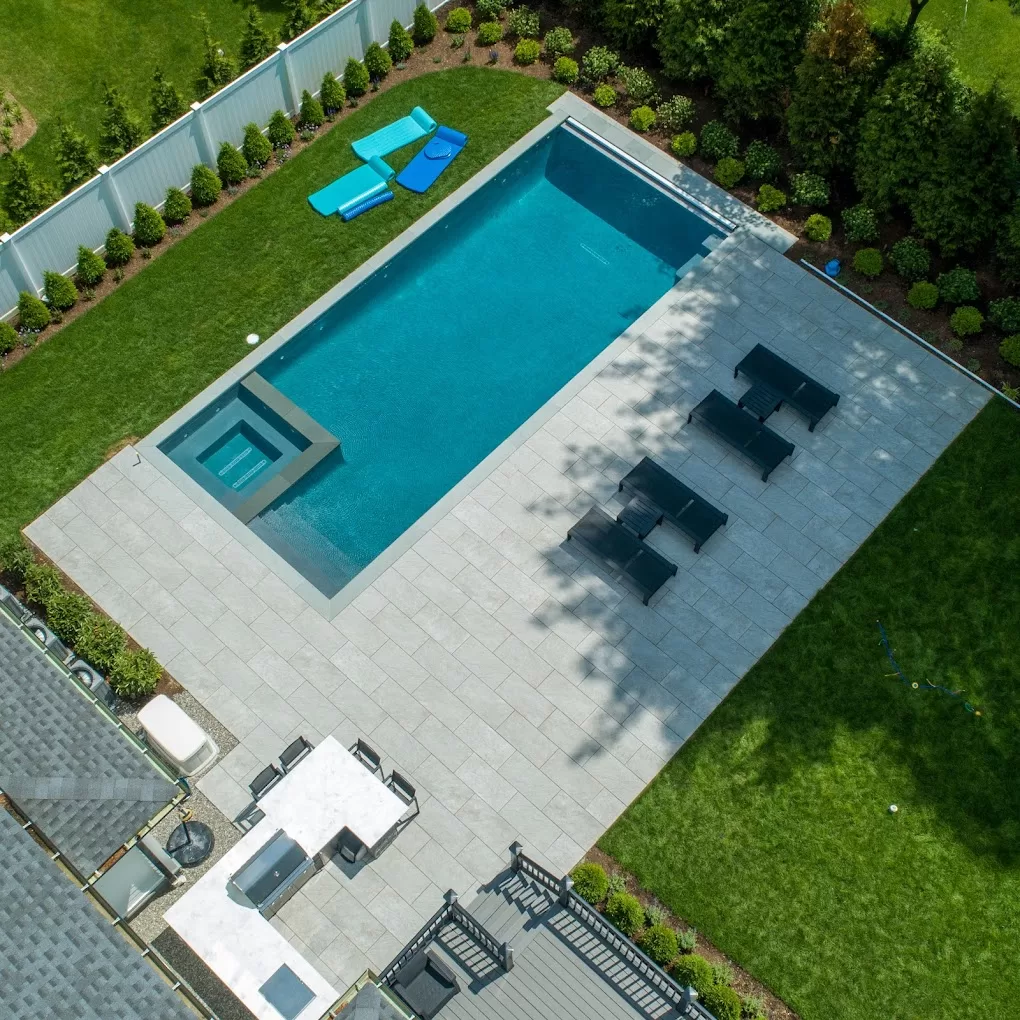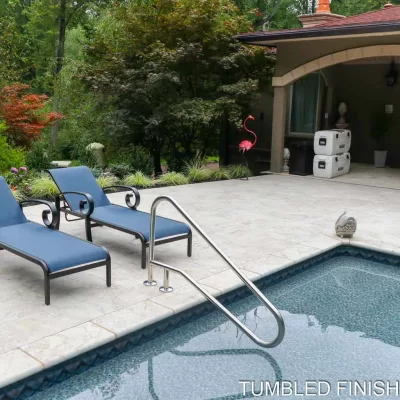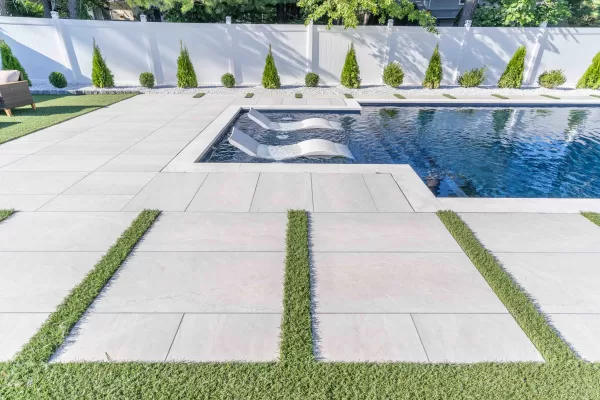Freeze-Thaw of Outdoor Marble, Travertine, and Porcelain Pavers: Essential Maintenance Tips
Outdoor spaces often feature materials such as marble, travertine, and porcelain pavers due to their natural beauty and durability. However, these materials can also be susceptible to the effects of freeze-thaw cycles, which occur when temperatures fluctuate between freezing and thawing, causing water to expand and contract within the pavers. This process can lead to cracks, flaking, and other damage that can compromise the integrity and appearance of outdoor paving materials.
Understanding the properties and vulnerabilities of materials like marble, travertine, and porcelain pavers is crucial for both homeowners and landscaping professionals. This enables proper installation, maintenance, and care for outdoor pavers, preventing potential damage from freeze-thaw cycles. Additionally, exploring emerging technologies in freeze-thaw resistance and implementing protective measures can further enhance the longevity and performance of these paver materials in cold climates.
Key Takeaways
- Understanding freeze-thaw impacts on pavers is essential for proper installation and maintenance
- Prevention and emerging technologies can help protect pavers in cold climates
- Case studies and detailed maintenance tips can provide insight for homeowners and professionals
Types of Pavers
Outdoor Marble
Outdoor marble pavers are popular for their elegant appearance and unique veining patterns. They are valued for their ability to stay cool in hot climates, making them suitable for sun-soaked outdoor areas. However, marble is a porous stone, which makes it susceptible to staining and damage from freeze-thaw cycles. To maintain its beauty and durability, it may require regular sealing and careful maintenance.
Travertine
Travertine is another natural stone option often chosen for its earthy tones and unique textures. Unlike marble, travertine pavers have a more porous surface, which can help retain minimal heat, making them ideal for warm climates. A standard thickness for outdoor use is 1 ¼-inch, but a 2-inch thickness may be more appropriate for cold climates to prevent issues during freeze-thaw cycles. Travertine also requires regular sealing and maintenance to maintain its appearance and durability.
Porcelain
Porcelain pavers are a versatile alternative to natural stone options. They are made from dense, high-quality materials, which provide excellent resistance to moisture absorption. This feature not only makes them stain-resistant but also less susceptible to mold and moss growth. Porcelain pavers can withstand freeze-thaw cycles better than marble and travertine, making them a low-maintenance choice for both cold and warm climates. With various styles available, they can mimic the appearance of natural stone, providing an attractive and durable option for outdoor spaces.
Impacts of Freeze-Thaw on Pavers
Physical Changes
Freeze-thaw cycles can cause significant physical changes to outdoor marble, travertine, and porcelain pavers. Water absorbed by the pavers expands when it freezes, leading to increased pressure within the material. Upon thawing, the pressure is released, potentially causing cracks or gaps in the pavers. This process can repeat multiple times in cold climates, resulting in more severe damages.
For example, Travertine Pavers can withstand freeze-thaw cycles due to their porosity and quick water absorption, which overall contributes to better durability in cold climates. On the other hand, Marble and Porcelain Pavers are denser and less porous, which may make them more susceptible to damage caused by freeze-thaw cycles.
Aesthetic Implications
The physical changes induced by freeze-thaw cycles can also affect the aesthetics of outdoor marble, travertine, and porcelain pavers. Cracks, gaps, and other damages can make the pavers appear worn and weathered. As these damages accumulate, the overall appearance of the paved area may become less appealing.
Additionally, the freeze-thaw process may cause:
- Color changes: Moisture and ice formation can lead to discoloration in the pavers, making them appear dull or faded.
- Surface irregularities: As pavers expand and contract, it is possible for them to shift and become uneven, leading to an irregular surface.
Preventive measures, such as using sealants or proper installation techniques, can help mitigate the impact of freeze-thaw cycles on the aesthetics and functionality of outdoor pavers.
Preventive Measures to Safeguard Pavers
To ensure the longevity of outdoor marble, travertine, and porcelain pavers in cold climates, it is crucial to implement preventive measures. These measures include careful selection of materials, proper installation, and appropriate sealing techniques.
Selection of Material
Choosing suitable materials for cold climates helps to minimize the risk of freeze-thaw damage. For instance, permeable brick pavers are ideal for cold climates because they do not absorb water and are resistant to freezing. Another option is travertine, which has become more suitable for cold climates since it can now be sealed to protect it from its naturally porous nature.
Proper Installation
Proper installation plays a significant role in safeguarding pavers from cold weather damage. Ensure that the base and sub-base materials are carefully selected and compacted, promoting drainage and preventing water accumulation. Use a layer of stone dust or sand to provide adequate support and allow for proper joint widths. It is critical to manage the expansion and contraction of pavers during freeze-thaw cycles by incorporating expansion joints and edge restraints to prevent shifting or cracking.
Sealing Techniques
Sealing techniques help protect pavers from the harsh effects of cold climates. Sealants can prevent water absorption and resistance to salts, chemicals, and stains. Before applying a sealant, clean the pavers thoroughly to remove dirt and debris. It is essential to choose the right type of sealant for the specific material being used, whether it be marble, travertine, or porcelain pavers. Regularly reseal pavers as needed, following the manufacturer’s recommendations to ensure optimal protection against freeze-thaw damage.
Maintenance Tips for Pavers During Freeze-Thaw
Maintaining the appearance and integrity of outdoor marble, travertine, and porcelain pavers can be challenging during freeze-thaw cycles. However, there are steps you can take to minimize damage and keep your pavers looking their best.
First, it’s important to ensure that your pavers are properly installed. This includes using a suitable base material and ensuring proper drainage to prevent water from pooling on the surface. Additionally, opting for pavers with a low water absorption rate can help reduce the risk of damage in cold climates. If possible, consult with a professional to select pavers that meet ASTM C1645 standards for freeze-thaw durability.
Regular cleaning is essential, especially during freeze-thaw cycles. Sweeping your pavers daily can prevent the buildup of dust, soil, and other debris that contributes to stains and degradation. For deeper cleaning, you can use a power washer with light or moderate water pressure. Be sure to do this during a dry weather forecast, allowing the pavers to dry thoroughly before resealing.
Sealing your pavers is also crucial. Use a sealer specifically formulated for your paver material (marble, travertine, or porcelain). Sealers add an extra layer of protection against water penetration and can help prevent staining while extending the service life of your pavers. It is recommended to reseal your pavers every two or three years to maintain their appearance and performance.
Closely monitor your pavers for signs of damage, such as cracks, loose joints, or uneven surfaces. If you spot any issues, address them promptly. This can include filling cracks, re-leveling uneven pavers, or replacing severely damaged ones. One solution for preventing water infiltration in joints is using a product like Sandlock to create a rubberized bond, keeping water out and maintaining joint integrity.
Proactively addressing any problems that arise during freeze-thaw cycles will help extend the lifespan of your outdoor pavers, preserving their aesthetic appeal and structural integrity. By diligently following these maintenance tips, you can enjoy the beauty and functionality of your outdoor pavers for years to come.
Case Studies of Freeze-Thaw Damages
The freeze-thaw process can have significant impacts on outdoor marble, travertine, and porcelain pavers. In one long-term experiment, researchers observed the effects of freeze-thaw cycles on marble deterioration. The study revealed that Young’s modulus, which measures a material’s stiffness, is affected by these cycles. Consequently, materials like marble can undergo cracking and weakening over time due to the combined effects of heating, cooling, and moisture.
Travertine is also susceptible to freeze-thaw damage. Exposure to extreme temperature fluctuations can cause the paver’s surface to chip, crack, or erode. The porous nature of travertine makes it more vulnerable to deterioration, as water can penetrate the pores and expand when frozen, causing the material to fracture.
Porcelain pavers, on the other hand, display increased resistance to freeze-thaw damage, mainly due to their low porosity. However, poor installation and underlying issues can still cause problems. For instance, if the substrate below the pavers is not appropriately prepared or if the pavers are not installed with proper drainage, water can accumulate and freeze beneath them, potentially causing heaving or shifting.
In summary, freeze-thaw cycles can result in various damages to outdoor marble, travertine, and porcelain pavers. The type and extent of damage often depend on factors such as material properties, installation, and maintenance methods.
Emerging Technologies in Freeze-Thaw Resistance
In recent years, new technologies have emerged to improve the freeze-thaw resistance of outdoor pavers, ensuring longevity and durability in cold climates. The primary focus has been on materials such as marble, travertine, and porcelain pavers.
One cutting-edge development involves using nano-materials in the manufacturing process. These nano-materials provide higher resistance against freeze-thaw cycles due to their ability to enhance the material’s ability to cope with the expansion caused by freezing water. Incorporating such materials can dramatically improve the strength and performance of pavers in harsh weather conditions.
Besides nano-materials, the application of protective coatings on pavers has seen significant advancements. These coatings are specifically designed to make the paver surfaces impervious to water penetration, thereby reducing the risk of freeze-thaw damage. Hydrophobic coatings, for example, can effectively repel water and prevent its absorption into the paver material. This minimizes the potential for cracks and spalling caused by the expansion of freezing water.
Another promising technology is the use of geotextiles in the installation process. Geotextiles provide a stable and well-drained base beneath the pavers, promoting effective drainage and minimizing the buildup of moisture. This in turn helps to decrease the risk of frost heave, which occurs when water in the ground expands during freezing, causing soil and subsequently installed surfaces to shift.
In conclusion, the combination of innovative materials, protective coatings, and installation techniques is creating new possibilities for durable and long-lasting outdoor pavers in cold climates. With an increased understanding of freeze-thaw resistance, manufacturers and installers can make informed decisions when selecting the appropriate materials and methods to withstand harsh weather conditions.
Frequently Asked Questions
How do freeze-thaw cycles affect outdoor marble pavers?
Freeze-thaw cycles can cause damage to outdoor marble pavers as the absorbed water inside the pavers expands when it freezes and contracts when it thaws, leading to cracks and deterioration. To minimize the impacts of freeze-thaw cycles, proper installation methods and regular maintenance are necessary.
Can travertine pavers withstand freeze-thaw conditions?
Yes, travertine pavers can withstand freeze-thaw conditions. They are durable and can endure the fluctuations of cold weather and harsh freeze-thaw cycles in various climates. However, proper installation and maintenance are still crucial to ensure their longevity.
Are porcelain pavers suitable for cold climates with freeze-thaw cycles?
Outdoor porcelain pavers are an excellent choice for cold climates with freeze-thaw cycles due to their low water absorption rate and high resistance to frost and extreme temperature changes. They are durable and can maintain their appearance and functionality in harsh weather conditions.
Which material is better for outdoor use in freeze-thaw areas: marble, travertine, or porcelain?
While all three materials can be used in outdoor areas with freeze-thaw cycles, each comes with its advantages and disadvantages. Porcelain pavers often provide the best performance due to their low water absorption rate and frost resistance. Travertine pavers come in second due to their ability to withstand freeze-thaw conditions with proper installation. Marble pavers can also be used, but they might require more maintenance to prevent potential damage from freeze-thaw cycles.
How can I protect my outdoor marble and travertine pavers from freeze-thaw damage?
Protecting outdoor marble and travertine pavers from freeze-thaw damage involves using proper installation techniques, such as sand-setting instead of mortar-setting for travertine pavers. This prevents cracking caused by the restriction of the material during freeze-thaw cycles. Additionally, regular maintenance, such as sealing the pavers to lower the water absorption rate and cleaning them to prevent the buildup of dirt and debris, is essential.
Do porcelain pavers require any special maintenance in freeze-thaw environments?
Porcelain pavers typically do not require any special maintenance in freeze-thaw environments due to their frost resistance and low water absorption rate. However, as with any outdoor material, it is important to perform regular maintenance, such as keeping the pavers clean, to maintain their appearance and functionality over time.




